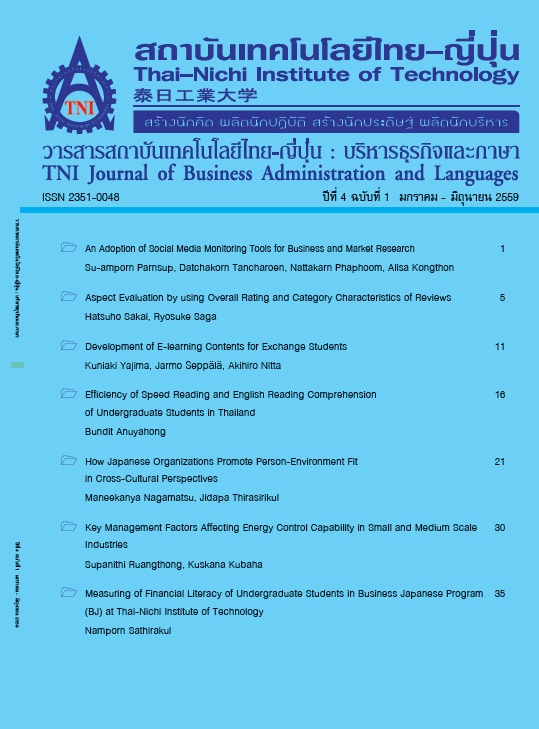Key Management Factors Affecting Energy Control Capability in Small and Medium Scale Industries
Main Article Content
Abstract
The objective of this research was to figure out the key management factors affecting the energy control capability of small and medium scale industries. A number of factories, which participated and implemented in energy conservation project was only focused. The multiple linear regressions method was used to analyze the energy control capability of the factory. The capability was considered as a function of various management factors, and deduced by the determination coefficient of energy equation. The results declared that the role of top management played important role in which accounted to 33%, while the investment, motivation and organization were affected about 30%, 12% and 11% respectively. In term of, the qualification of energy management representative, the person who graduated in engineering area was affected by 14%. Nevertheless, the other management factors were not significantly affecting the energy control capability.
Article Details
Article Accepting Policy
The editorial board of Thai-Nichi Institute of Technology is pleased to receive articles from lecturers and experts in the fields of business administration, languages, engineering and technology written in Thai or English. The academic work submitted for publication must not be published in any other publication before and must not be under consideration of other journal submissions. Therefore, those interested in participating in the dissemination of work and knowledge can submit their article to the editorial board for further submission to the screening committee to consider publishing in the journal. The articles that can be published include solely research articles. Interested persons can prepare their articles by reviewing recommendations for article authors.
Copyright infringement is solely the responsibility of the author(s) of the article. Articles that have been published must be screened and reviewed for quality from qualified experts approved by the editorial board.
The text that appears within each article published in this research journal is a personal opinion of each author, nothing related to Thai-Nichi Institute of Technology, and other faculty members in the institution in any way. Responsibilities and accuracy for the content of each article are owned by each author. If there is any mistake, each author will be responsible for his/her own article(s).
The editorial board reserves the right not to bring any content, views or comments of articles in the Journal of Thai-Nichi Institute of Technology to publish before receiving permission from the authorized author(s) in writing. The published work is the copyright of the Journal of Thai-Nichi Institute of Technology.
References
F. Apostolos, P. Alexios, P. Georgios, S. Panagiotis, and C.George, “Energy Efficiency of Manufacturing Processes: ACritical Review,” Procedia CIRP, vol. 7, pp. 628 - 633, 2013.
T. Javied, T. Rackow, and J. Franke, “Implementing Energy Management System to Increase Energy Efficiency in Manufacturing Companies,” Procedia CIRP, vol. 26, pp. 156 - 161, 2015.
A. Hasanbeigi, C. Menke, and P. du Pont, “Barriers to energy effi¬ciency improvement and decision-making behavior in Thai industry,” Energy Efficiency, vol. 3, no. 1, pp. 33–52, 2010.
V. Blass, C. J. Corbett, M. A. Delmas, and S. Muthulingam, “Top management and the adoption of energy efficiency practices: Evidence from small and medium sized manufacturing firms in the US,” Energy, vol. 65, pp. 560–571, Feb. 2014.
B. Sudhakara Reddy, “Barriers and drivers to energy efficiency - A new taxonomical approach,” Energy Conversion and Management, vol. 74, pp. 403 - 416, Oct. 2013.
A. Trianni and E. Cagno, “Dealing with barriers to energy efficiency and SMEs: Some empirical evidences,” Energy, vol. 37, no. 1, pp. 4949 - 504, Jan. 2012.
E. Cagno, P. Trucco, A. Trianni, and G. Sala, “Quick-E-scan: A methodology for the energy scan of SMEs,” Energy, vol. 35, no. 5, pp. 1916-1926, May 2010.
Ministry of Industry, Criteria of the Prime Minister Industry Award (Energy Management). Bangkok: n.p., 2010.
T. Virtanen, M. Tuomaala, and E. Pentti, “Energy efficiency complexities: A technical and managerial investigation,” Management Accounting Research, vol. 24, no. 4, pp. 401-416, Dec. 2013.
S. Önüt and S. Soner, “Analysis of energy use and efficiency in Turkish manufacturing sector SMEs,” Energy Conversion and Management, vol. 48, no. 2, pp. 384 - 394, Feb. 2007.
T. Virkki-Hatakka, M. Luoranen, and M. Ikävalko, “Differences in perception: How the experts look at energy efficiency (findings from a Finnish survey),” Energy Policy, vol. 60, pp. 499-508, Sep. 2013.
D. Y.-L. Chan, C.-F. Huang, W.-C. Lin, and G.-B. Hong, “Energy efficiency benchmarking of energy-intensive industries in Taiwan,” Energy Conversion and Management, vol. 77, pp. 216 - 220, Jan. 2014.
King Mongkut’s University of Technology Thonburi,Energy Efficiency in Plastics Industry. Bangkok: KMUTT, 1995.
A. Khoshroo, R. Mulwa, A. Emrouznejad, and B. Arabi, “A non-para¬metric Data Envelopment Analysis approach for improving energy efficiency of grape production,” Energy, vol. 63, pp. 189 - 194, Dec. 2013.
S. Thiede, G. Posselt, and C. Herrmann, “SME appropriate concept for continuously improving the energy and resource efficiency in manufacturing companies,” CIRP Journal of Manufacturing Science and Technology, vol. 6, no. 3, pp. 204-211, 2013.
K. Tanaka, “Assessing Measures of Energy Efficiency Performance and Their Application in Industry,” 2008. [Online]. Available:https://www.iea.org/publications/freepublications/publication/jprg_info _ paper-1.pdf.
Department of Renewable Energy and Energy Conservation, Handbook of Energy Management System Development. Bangkok: Ministry of Energy, 2009.


